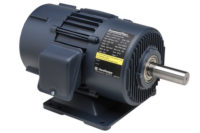There is a constant need and desire throughout the HVAC industry to spur innovation and create new products and ideas that can redefine the marketplace. In the realm of motors, the permanent magnet synchronous motor (PMSM) is a relatively obscure option that is gaining significant traction in the space.
The overall global electric motor market was valued at $99.85 billion in 2014 and is expected to reach $141.7 billion by 2022, according to a report issued by Grand View Research. The market is expected to increase at a compound annual growth rate (CAGR) of 4.5 percent from 2015 to 2022.
In this space, the PMSM is showcasing itself as an important piece of that estimated growth.
According to Tim Schamel, vice president and general manager, HVACR and appliance motors, Nidec Motor Corp., a PMSM is an AC synchronous motor whose field excitation is provided by permanent magnets. These motors typically have sinusoidal Back EMF waveforms. The rotor assembly has the permanent magnets surrounded by three equally spaced windings, which are fixed to the stator assembly. Torque is then produced by the attraction or repulsion between the stator field and magnetic field of the rotor.
PMSM is also known more widely in the industry as electronically commutated motors (ECMs).
Brent Boyd, director of variable speed engineering, air conditioning, Emerson commercial and residential solutions, said PMSMs contrast from more common induction motors in that they must energize both the rotor and stator to create a magnetic field in the motor. As a result, PMSM motors often require less work and are therefore more efficient.
WHERE IT STANDS
PMSM’s are currently most often seen in high-efficiency systems. Katrina Krites, variable speed market manager, air conditioning, Emerson commercial and residential solutions, said there are compressors, high-efficiency condenser fans, indoor fans, and geothermal water pumps that employ this technology in the market today.
The efficiency benefits provided by these motors mean they can provide value to multiple segments of the market.
“PMSMs provide energy-saving alternatives to manufacturers, contractors, end users, and homeowners,” Schamel said. “These products consume very little energy, particularly when multiple motor speeds or variable-speed performance is desired. These products also help manufacturers and contractors meet energy consumption objectives required by U.S. Department of Energy [DOE] legislation, Energy Star requirements, and utility rebates.”
Within the space, Nidec currently has PMSM designs for use in residential applications, including indoor applications — like furnaces and air handlers — as well as outdoor applications for air conditioners and heat pumps.
“Constant airflow is the No. 1 HVAC system benefit, and because of the internal workings of the motor, it can deliver constant airflow under a variety of conditions,” said Schamel. “The motor delivers what it’s told to deliver, no more, no less, by utilizing a software algorithm that can be adjusted by the OEM. This means no overblowing at lower statics and no loss of flow at higher statics due to system changes in the home or commercial ductwork structure. You get what you ask for from a compact direct-drive blower, which maximizes consistent temperature control. Also, the power usage of the motor is only that which is necessary to meet the needs of the HVAC system.”
Similarly, Emerson offers several models of variable-speed compressors ranging 2-20 ton. “The ZPV models are optimized for air-to-air applications while the ZHV model provides hot water heating capability often found in geothermal applications,” said Krites. “Emerson also offers motor drives or inverters that have been characterized for optimal performance with our variable-speed compressors. These products are applied across many residential and commercial applications, including split air conditioning and heat pumps, packaged systems, rooftops, chillers, and geothermal systems.”
FORECASTING THE FUTURE
With the electric motors market having strong growth projections over the next five years, manufacturers are excited about the progression of PMSMs.
“We anticipate PMSMs continuing to grow in popularity over the coming years in part to support efficiency regulation requirements both in commercial and residential spaces,” said Boyd.
Krites added that all of the major system manufacturers have a premium product that employs PMSM technology. “As the technology changes, costs decrease, which makes it easier to apply, thus we anticipate broader adoption,” she said
Schamel also expects popularity of PMSM’s to increase, with scheduled DOE rules for both residential and commercial HVAC equipment driving demand as well as end users and utilities interested in the benefits of reduced energy consumption.
In fact, the DOE recently issued a final rule pertaining to the certification, compliance, labeling, and enforcement for electric motors and small electric motors. Per the DOE, it is making revisions in order to conform to the certification, compliance, and enforcement regulations established by the department for all other covered products and equipment. The regulations adopted in the rule also provide specific sampling plans, certification requirements, alternate efficiency determination method requirements, and enforcement provisions for electric motors and small electric motors.”
“The DOE rules have really raised interest and awareness about these products,” said Schamel. “This increased awareness has resulted in a better understanding of not only the energy-savings potential of these designs but also an increased interest in the other benefits of improved temperature and humidity control, lower sound levels, consistent airflow, and better filtration.”
Boyd noted that PMSM technology is also expanding into niche and transport applications. “In addition, faster microelectronics and more efficient drives have the potential to increase adoption by driving down cost,” he said. “Given additional cost for the efficiency, there may be limits to where this technology is adopted in the future.”
One interesting note in the future of PMSMs may come in the form of increasing concerns over costs and the supply of rare earth magnets. Schamel said one advantage of PMSMs is that they can work with ferrite magnets.
“Ferrite magnets have a major disadvantage in that they don’t produce as much flux density as rare earth magnets do when the magnets are mounted on the surface of the rotor assembly, which leads to lower torque density,” he said. “The next-generation PMSM being developed for the HVAC industry [by Nidec] will have a spoke-type rotor technology. This new rotor technology uses low-cost ferrite magnets and tends to have a higher torque density than conventional surface mount rotor assemblies, which produces a lower cost motor construction.”
While the technology itself continues to change and evolve, so does customer awareness surrounding this option.
“In addition to lower energy consumption, these products have variable-speed capabilities that enable other benefits, including consistent temperature control, improved humidity control, lower sound levels, consistent airflow, and improved air filtration,” said Schamel. “All of these benefits will drive continued growth.”
“PMSM technology has been around for quite some time, and it is becoming more widely adopted in the HVACR industry,” said Krites. “OEMs understand the technology and have been using it in fans and compressors for years. Contractors recognize the benefits in efficiency and are growing in their appreciation of advanced diagnostics but seem to be less aware of the actual technology itself.”
Publication date: 2/6/2017
Want more HVAC industry news and information? Join The NEWS on Facebook, Twitter, and LinkedIn today!











